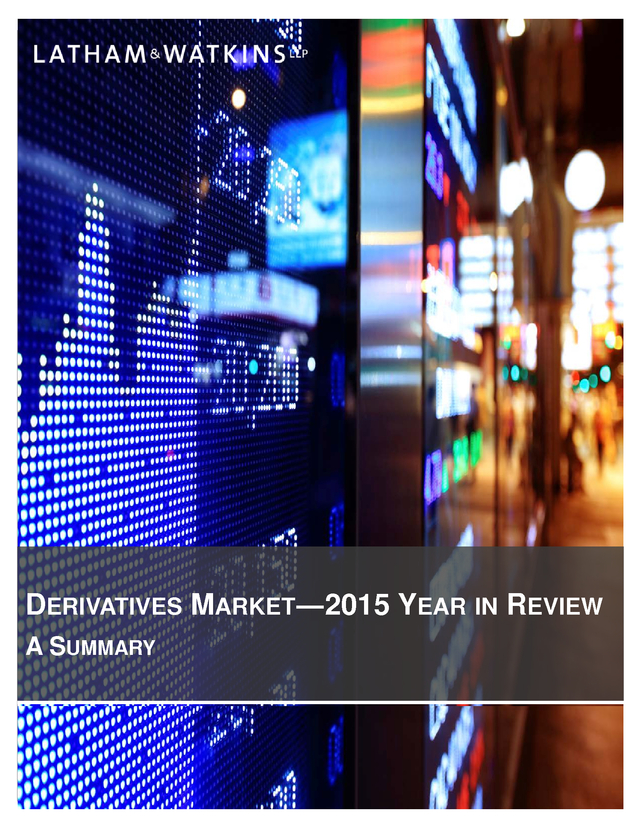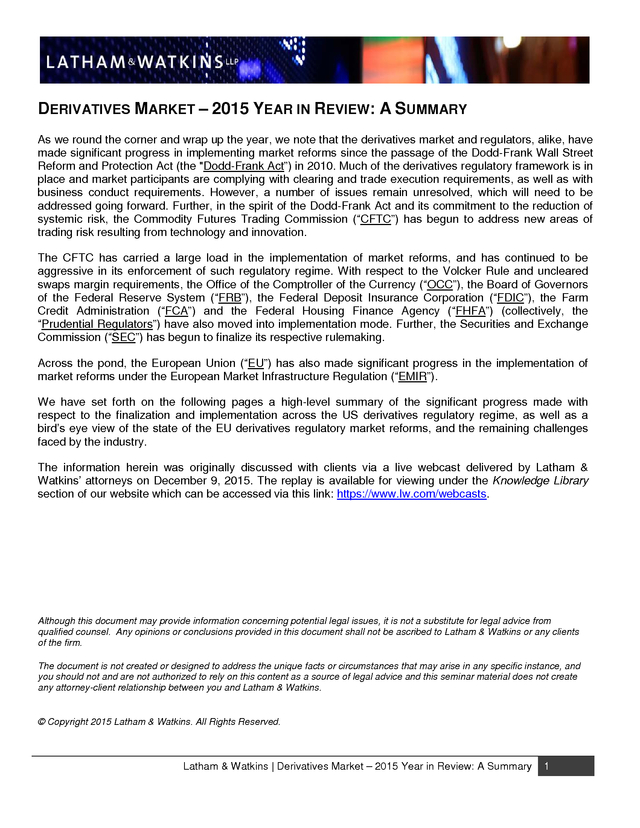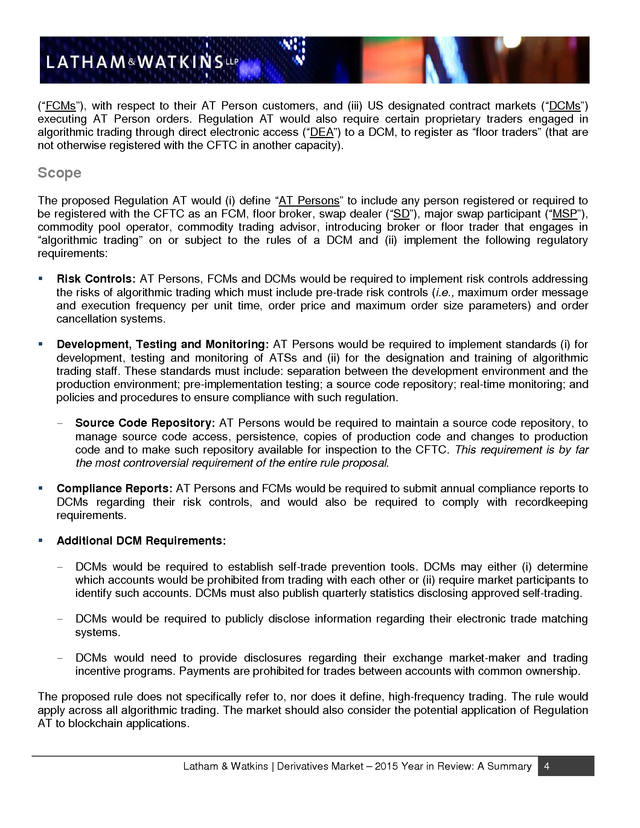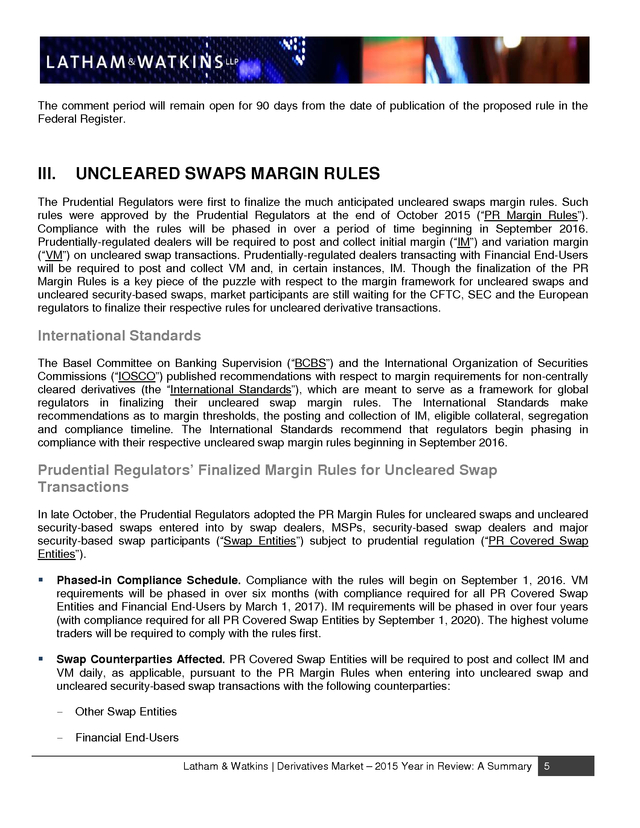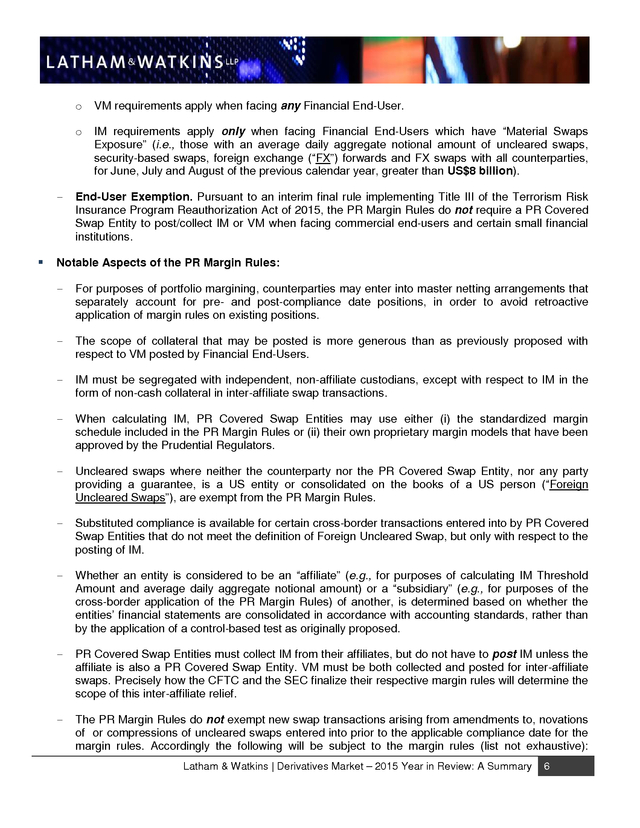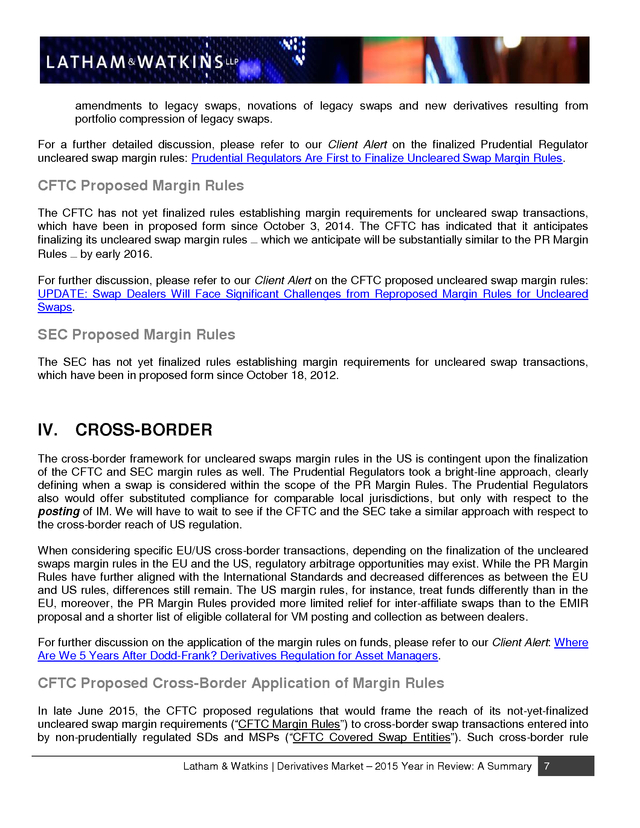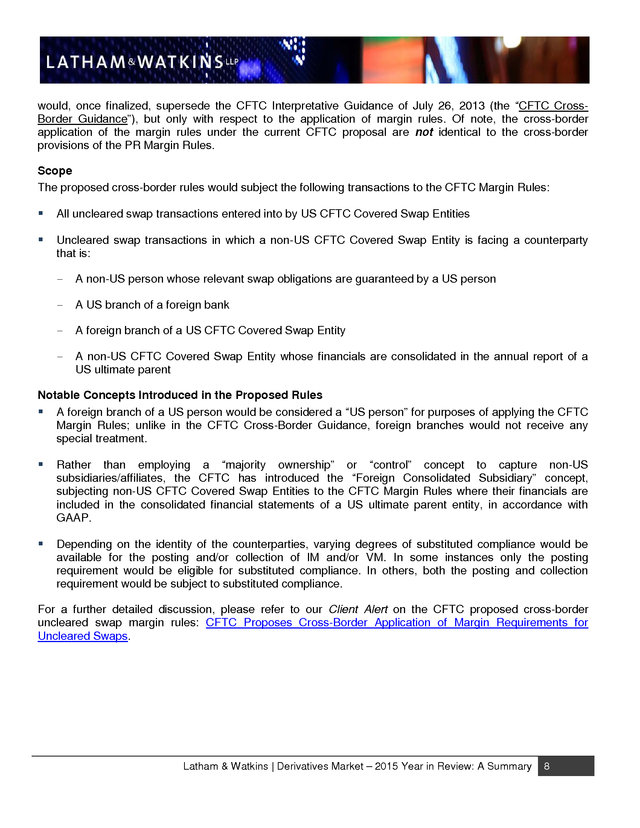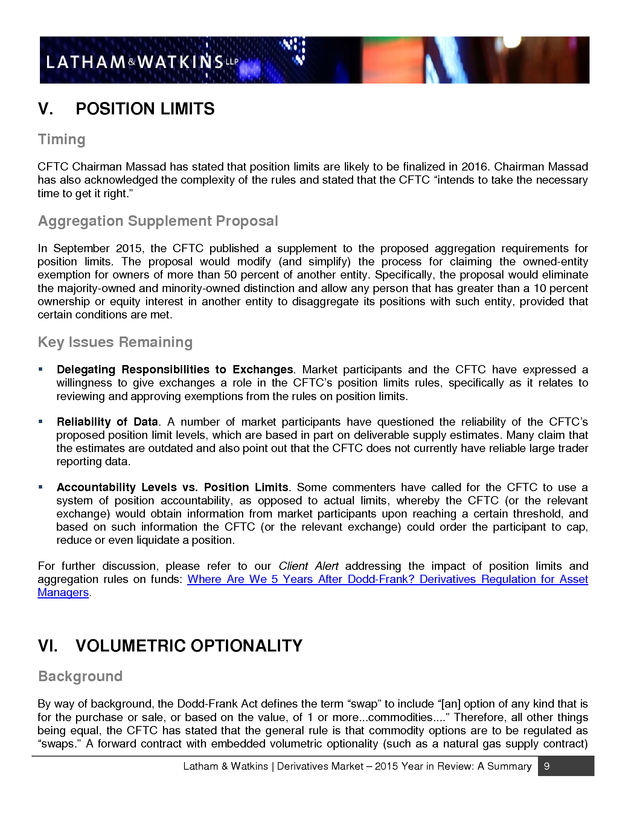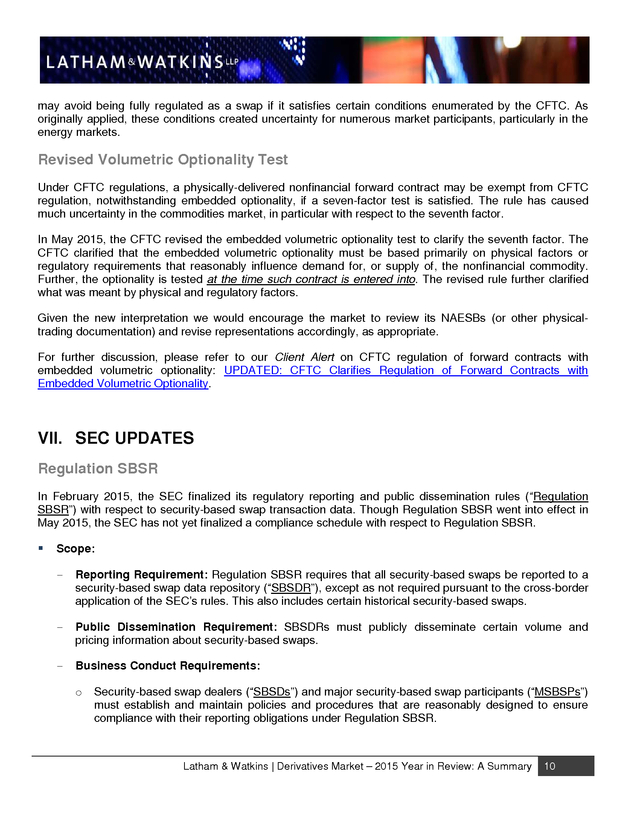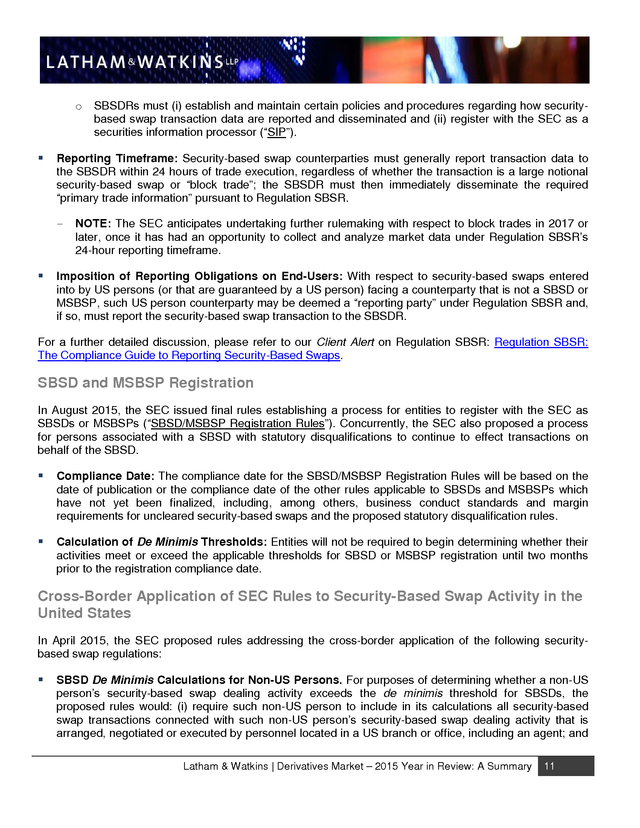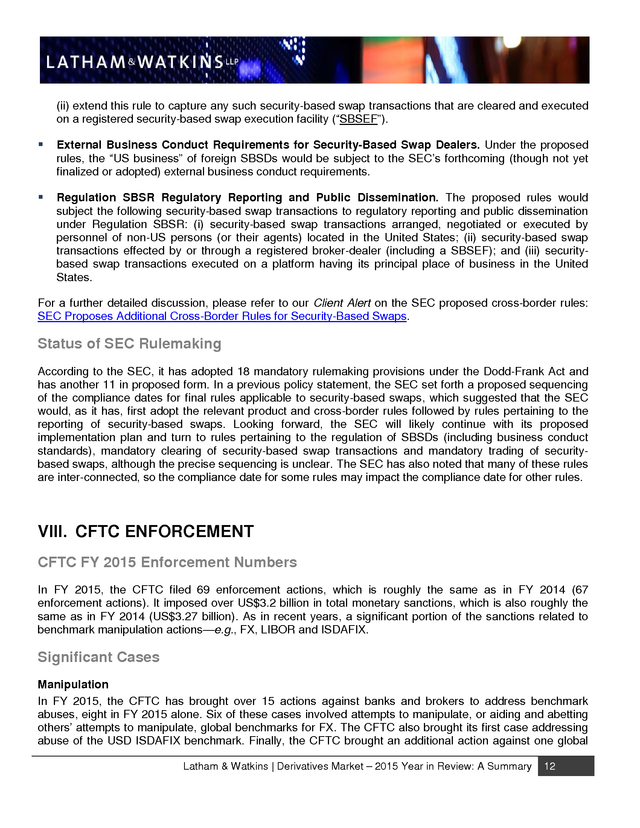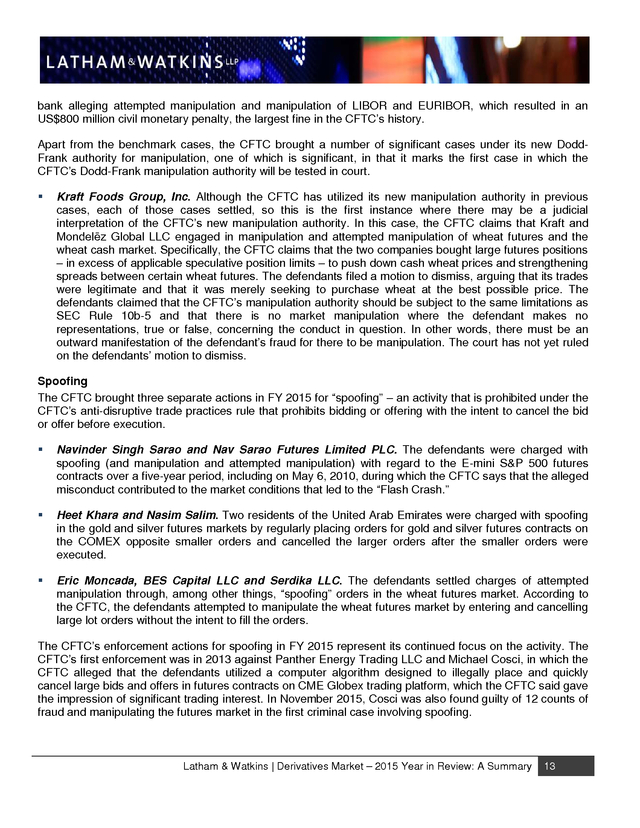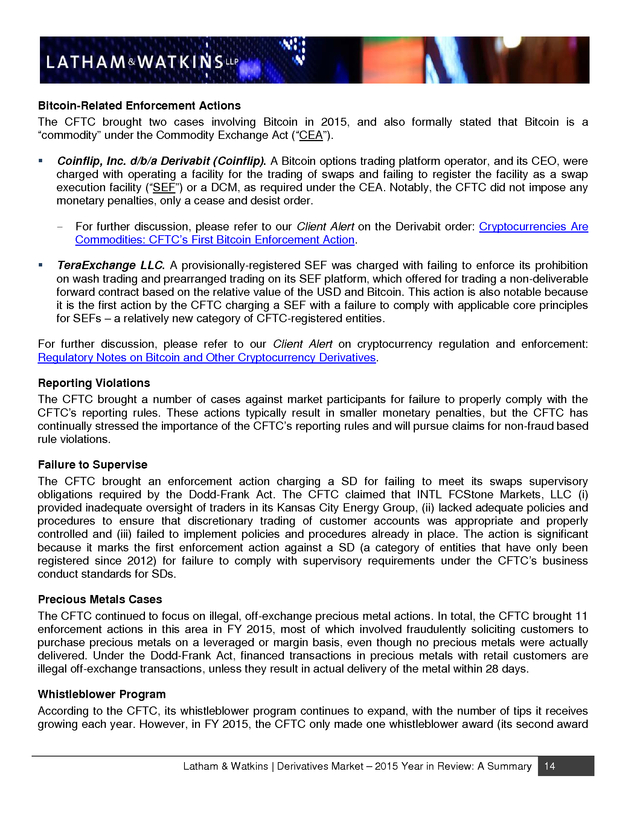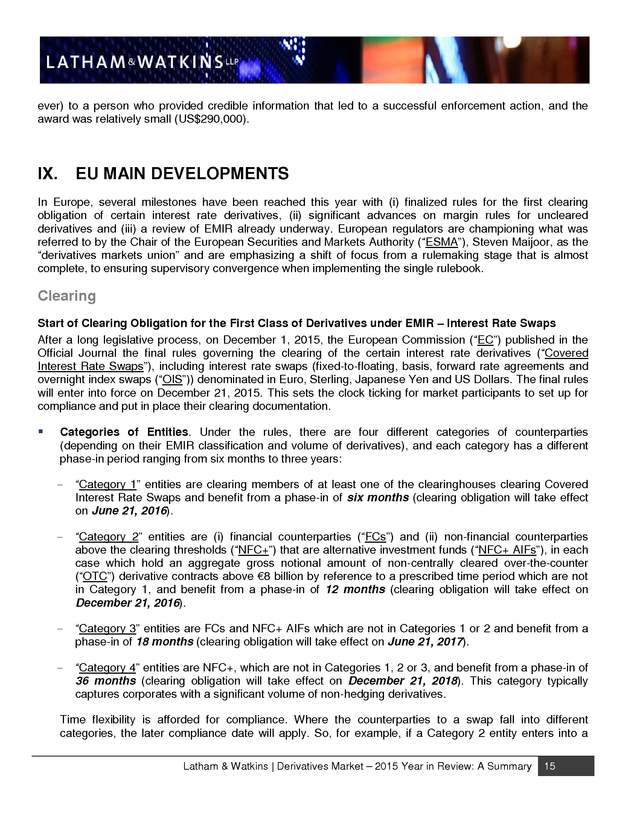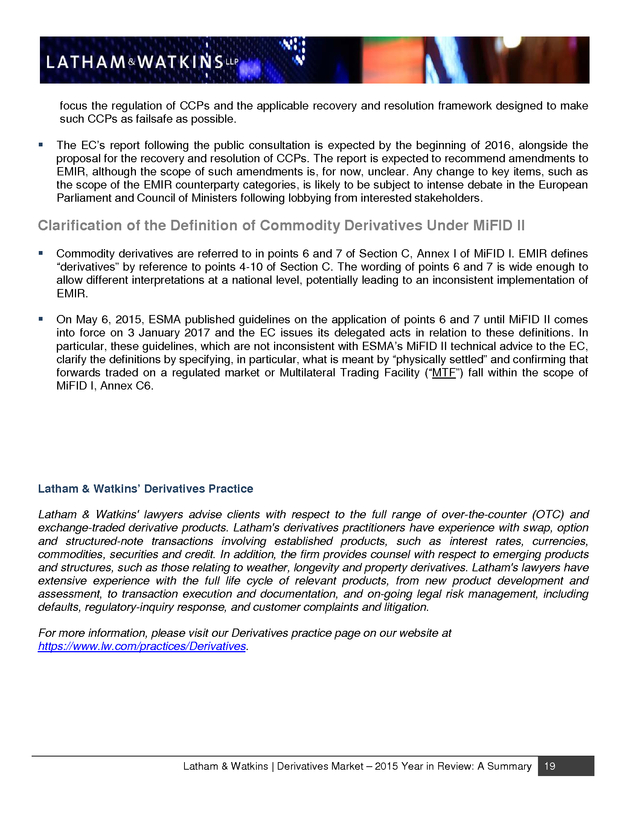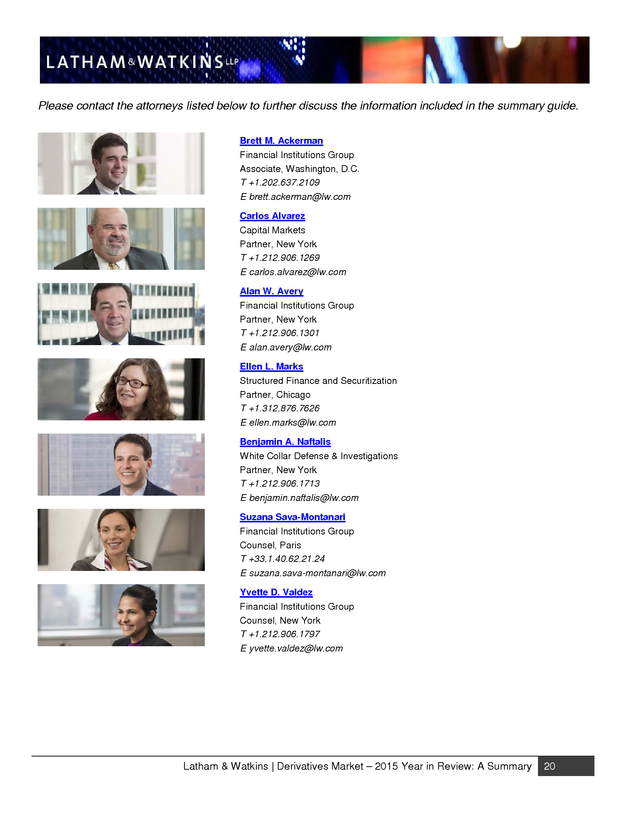
Severity: Notice
Message: Undefined variable: content_category
Filename: user/transcript.php
Line Number: 106
Severity: Warning
Message: Invalid argument supplied for foreach()
Filename: user/transcript.php
Line Number: 106




1) DERIVATIVES MARKET―2015 YEAR IN REVIEW A SUMMARY
2) DERIVATIVES MARKET – 2015 YEAR IN REVIEW: A SUMMARY As we round the corner and wrap up the year, we note that the derivatives market and regulators, alike, have made significant progress in implementing market reforms since the passage of the Dodd-Frank Wall Street Reform and Protection Act (the "Dodd-Frank Act”) in 2010. Much of the derivatives regulatory framework is in place and market participants are complying with clearing and trade execution requirements, as well as with business conduct requirements. However, a number of issues remain unresolved, which will need to be addressed going forward. Further, in the spirit of the Dodd-Frank Act and its commitment to the reduction of systemic risk, the Commodity Futures Trading Commission (“CFTC”) has begun to address new areas of trading risk resulting from technology and innovation. The CFTC has carried a large load in the implementation of market reforms, and has continued to be aggressive in its enforcement of such regulatory regime. With respect to the Volcker Rule and uncleared swaps margin requirements, the Office of the Comptroller of the Currency (“OCC”), the Board of Governors of the Federal Reserve System (“FRB”), the Federal Deposit Insurance Corporation (“FDIC”), the Farm Credit Administration (“FCA”) and the Federal Housing Finance Agency (“FHFA”) (collectively, the “Prudential Regulators”) have also moved into implementation mode. Further, the Securities and Exchange Commission (“SEC”) has begun to finalize its respective rulemaking. Across the pond, the European Union (“EU”) has also made significant progress in the implementation of market reforms under the European Market Infrastructure Regulation (“EMIR”). We have set forth on the following pages a high-level summary of the significant progress made with respect to the finalization and implementation across the US derivatives regulatory regime, as well as a bird’s eye view of the state of the EU derivatives regulatory market reforms, and the remaining challenges faced by the industry. The information herein was originally discussed with clients via a live webcast delivered by Latham & Watkins’ attorneys on December 9, 2015. The replay is available for viewing under the Knowledge Library section of our website which can be accessed via this link: https://www.lw.com/webcasts. Although this document may provide information concerning potential legal issues, it is not a substitute for legal advice from qualified counsel. Any opinions or conclusions provided in this document shall not be ascribed to Latham & Watkins or any clients of the firm. The document is not created or designed to address the unique facts or circumstances that may arise in any specific instance, and you should not and are not authorized to rely on this content as a source of legal advice and this seminar material does not create any attorney-client relationship between you and Latham & Watkins. © Copyright 2015 Latham & Watkins. All Rights Reserved. Latham & Watkins | Derivatives Market – 2015 Year in Review: A Summary 1
3) TABLE OF CONTENTS I. VOLCKER RULE ............................................................................................................ 3 Overview .......................................................................................................................................... 3 Current Status .................................................................................................................................. 3 Some Early Implementation Challenges .......................................................................................... 3 II. REGULATION AUTOMATED TRADING........................................................................ 3 Scope ............................................................................................................................................... 4 III. UNCLEARED SWAPS MARGIN RULES ....................................................................... 5 International Standards .................................................................................................................... 5 Prudential Regulators’ Finalized Margin Rules for Uncleared Swap Transactions ......................... 5 CFTC Proposed Margin Rules ......................................................................................................... 7 SEC Proposed Margin Rules ........................................................................................................... 7 IV. CROSS-BORDER .......................................................................................................... 7 CFTC Proposed Cross-Border Application of Margin Rules ............................................................ 7 V. POSITION LIMITS .......................................................................................................... 9 Timing............................................................................................................................................... 9 Aggregation Supplement Proposal .................................................................................................. 9 Key Issues Remaining ..................................................................................................................... 9 VI. VOLUMETRIC OPTIONALITY ....................................................................................... 9 Background ...................................................................................................................................... 9 Revised Volumetric Optionality Test .............................................................................................. 10 VII. SEC UPDATES ............................................................................................................ 10 Regulation SBSR ........................................................................................................................... 10 SBSD and MSBSP Registration .................................................................................................... 11 Cross-Border Application of SEC Rules to Security-Based Swap Activity in the United States .... 11 Status of SEC Rulemaking............................................................................................................. 12 VIII. CFTC ENFORCEMENT .............................................................................................. 12 CFTC FY 2015 Enforcement Numbers .......................................................................................... 12 Significant Cases ........................................................................................................................... 12 IX. EU MAIN DEVELOPMENTS ........................................................................................ 15 Clearing .......................................................................................................................................... 15 Margining for Uncleared Swaps ..................................................................................................... 17 Review of EMIR’s Implementation ................................................................................................. 18 Clarification of the Definition of Commodity Derivatives Under MiFID II ....................................... 19 Latham & Watkins | Derivatives Market – 2015 Year in Review: A Summary 2
4) I. VOLCKER RULE Overview The Volcker Rule’s implementing regulations, issued by the five responsible agencies (the FRB, the OCC, the FDIC, the SEC and the CFTC) in December 2013, prohibits any “banking entity” from (i) engaging in proprietary trading or (ii) acquiring or retaining ownership interests in, sponsoring or having certain relationships with a “covered fund.” These prohibitions are subject to a number of exemptions, exclusions and definitions. Current Status The statutory conformance period, which was originally set to end July 21, 2014, was extended by the FRB until July 21, 2015 for most proprietary trading and covered fund-related activities. Accordingly, the Volcker Rule’s requirements are now fully effective, with two exceptions:  The FRB announced its intention to grant two one-year extensions (until July 21, 2017) to conform ownership interests and sponsorship of certain collateralized loan obligations (“CLOs”).  The FRB also announced its intention to grant two one-year extensions (until July 21, 2017) to conform investments in and relationships with covered funds and foreign funds that were in place prior to December 31, 2013 (“legacy funds”). Some Early Implementation Challenges  Policies, procedures and other requirements  Application of proprietary trading exemptions to derivatives  Scope of “ownership interest” definition -  Notes or similar instruments Derivatives Scope of “covered fund” definition For further discussion, please refer to our Client Alert on the extended Volcker Rule conformance deadline: Volcker Rule Conformance Deadline Extended for Certain Funds. II. REGULATION AUTOMATED TRADING In late November, the CFTC proposed Regulation Automated Trading (“Regulation AT”), which would impose risk controls, transparency measures and other requirements on (i) certain market participants (“AT Persons”) using algorithmic trading systems (“ATSs”), (ii) clearing member futures commission merchants Latham & Watkins | Derivatives Market – 2015 Year in Review: A Summary 3
5) (“FCMs”), with respect to their AT Person customers, and (iii) US designated contract markets (“DCMs”) executing AT Person orders. Regulation AT would also require certain proprietary traders engaged in algorithmic trading through direct electronic access (“DEA”) to a DCM, to register as “floor traders” (that are not otherwise registered with the CFTC in another capacity). Scope The proposed Regulation AT would (i) define “AT Persons” to include any person registered or required to be registered with the CFTC as an FCM, floor broker, swap dealer (“SD”), major swap participant (“MSP”), commodity pool operator, commodity trading advisor, introducing broker or floor trader that engages in “algorithmic trading” on or subject to the rules of a DCM and (ii) implement the following regulatory requirements:  Risk Controls: AT Persons, FCMs and DCMs would be required to implement risk controls addressing the risks of algorithmic trading which must include pre-trade risk controls (i.e., maximum order message and execution frequency per unit time, order price and maximum order size parameters) and order cancellation systems.  Development, Testing and Monitoring: AT Persons would be required to implement standards (i) for development, testing and monitoring of ATSs and (ii) for the designation and training of algorithmic trading staff. These standards must include: separation between the development environment and the production environment; pre-implementation testing; a source code repository; real-time monitoring; and policies and procedures to ensure compliance with such regulation. - Source Code Repository: AT Persons would be required to maintain a source code repository, to manage source code access, persistence, copies of production code and changes to production code and to make such repository available for inspection to the CFTC. This requirement is by far the most controversial requirement of the entire rule proposal.  Compliance Reports: AT Persons and FCMs would be required to submit annual compliance reports to DCMs regarding their risk controls, and would also be required to comply with recordkeeping requirements.  Additional DCM Requirements: - DCMs would be required to establish self-trade prevention tools. DCMs may either (i) determine which accounts would be prohibited from trading with each other or (ii) require market participants to identify such accounts. DCMs must also publish quarterly statistics disclosing approved self-trading. - DCMs would be required to publicly disclose information regarding their electronic trade matching systems. - DCMs would need to provide disclosures regarding their exchange market-maker and trading incentive programs. Payments are prohibited for trades between accounts with common ownership. The proposed rule does not specifically refer to, nor does it define, high-frequency trading. The rule would apply across all algorithmic trading. The market should also consider the potential application of Regulation AT to blockchain applications. Latham & Watkins | Derivatives Market – 2015 Year in Review: A Summary 4
6) The comment period will remain open for 90 days from the date of publication of the proposed rule in the Federal Register. III. UNCLEARED SWAPS MARGIN RULES The Prudential Regulators were first to finalize the much anticipated uncleared swaps margin rules. Such rules were approved by the Prudential Regulators at the end of October 2015 (“PR Margin Rules”). Compliance with the rules will be phased in over a period of time beginning in September 2016. Prudentially-regulated dealers will be required to post and collect initial margin (“IM”) and variation margin (“VM”) on uncleared swap transactions. Prudentially-regulated dealers transacting with Financial End-Users will be required to post and collect VM and, in certain instances, IM. Though the finalization of the PR Margin Rules is a key piece of the puzzle with respect to the margin framework for uncleared swaps and uncleared security-based swaps, market participants are still waiting for the CFTC, SEC and the European regulators to finalize their respective rules for uncleared derivative transactions. International Standards The Basel Committee on Banking Supervision (“BCBS”) and the International Organization of Securities Commissions (“IOSCO”) published recommendations with respect to margin requirements for non-centrally cleared derivatives (the “International Standards”), which are meant to serve as a framework for global regulators in finalizing their uncleared swap margin rules. The International Standards make recommendations as to margin thresholds, the posting and collection of IM, eligible collateral, segregation and compliance timeline. The International Standards recommend that regulators begin phasing in compliance with their respective uncleared swap margin rules beginning in September 2016. Prudential Regulators’ Finalized Margin Rules for Uncleared Swap Transactions In late October, the Prudential Regulators adopted the PR Margin Rules for uncleared swaps and uncleared security-based swaps entered into by swap dealers, MSPs, security-based swap dealers and major security-based swap participants (“Swap Entities”) subject to prudential regulation (“PR Covered Swap Entities”).  Phased-in Compliance Schedule. Compliance with the rules will begin on September 1, 2016. VM requirements will be phased in over six months (with compliance required for all PR Covered Swap Entities and Financial End-Users by March 1, 2017). IM requirements will be phased in over four years (with compliance required for all PR Covered Swap Entities by September 1, 2020). The highest volume traders will be required to comply with the rules first.  Swap Counterparties Affected. PR Covered Swap Entities will be required to post and collect IM and VM daily, as applicable, pursuant to the PR Margin Rules when entering into uncleared swap and uncleared security-based swap transactions with the following counterparties: - Other Swap Entities - Financial End-Users Latham & Watkins | Derivatives Market – 2015 Year in Review: A Summary 5
7) o o -  VM requirements apply when facing any Financial End-User. IM requirements apply only when facing Financial End-Users which have “Material Swaps Exposure” (i.e., those with an average daily aggregate notional amount of uncleared swaps, security-based swaps, foreign exchange (“FX”) forwards and FX swaps with all counterparties, for June, July and August of the previous calendar year, greater than US$8 billion). End-User Exemption. Pursuant to an interim final rule implementing Title III of the Terrorism Risk Insurance Program Reauthorization Act of 2015, the PR Margin Rules do not require a PR Covered Swap Entity to post/collect IM or VM when facing commercial end-users and certain small financial institutions. Notable Aspects of the PR Margin Rules: - For purposes of portfolio margining, counterparties may enter into master netting arrangements that separately account for pre- and post-compliance date positions, in order to avoid retroactive application of margin rules on existing positions. - The scope of collateral that may be posted is more generous than as previously proposed with respect to VM posted by Financial End-Users. - IM must be segregated with independent, non-affiliate custodians, except with respect to IM in the form of non-cash collateral in inter-affiliate swap transactions. - When calculating IM, PR Covered Swap Entities may use either (i) the standardized margin schedule included in the PR Margin Rules or (ii) their own proprietary margin models that have been approved by the Prudential Regulators. - Uncleared swaps where neither the counterparty nor the PR Covered Swap Entity, nor any party providing a guarantee, is a US entity or consolidated on the books of a US person (“Foreign Uncleared Swaps”), are exempt from the PR Margin Rules. - Substituted compliance is available for certain cross-border transactions entered into by PR Covered Swap Entities that do not meet the definition of Foreign Uncleared Swap, but only with respect to the posting of IM. - Whether an entity is considered to be an “affiliate” (e.g., for purposes of calculating IM Threshold Amount and average daily aggregate notional amount) or a “subsidiary” (e.g., for purposes of the cross-border application of the PR Margin Rules) of another, is determined based on whether the entities’ financial statements are consolidated in accordance with accounting standards, rather than by the application of a control-based test as originally proposed. - PR Covered Swap Entities must collect IM from their affiliates, but do not have to post IM unless the affiliate is also a PR Covered Swap Entity. VM must be both collected and posted for inter-affiliate swaps. Precisely how the CFTC and the SEC finalize their respective margin rules will determine the scope of this inter-affiliate relief. - The PR Margin Rules do not exempt new swap transactions arising from amendments to, novations of or compressions of uncleared swaps entered into prior to the applicable compliance date for the margin rules. Accordingly the following will be subject to the margin rules (list not exhaustive): Latham & Watkins | Derivatives Market – 2015 Year in Review: A Summary 6
8) amendments to legacy swaps, novations of legacy swaps and new derivatives resulting from portfolio compression of legacy swaps. For a further detailed discussion, please refer to our Client Alert on the finalized Prudential Regulator uncleared swap margin rules: Prudential Regulators Are First to Finalize Uncleared Swap Margin Rules. CFTC Proposed Margin Rules The CFTC has not yet finalized rules establishing margin requirements for uncleared swap transactions, which have been in proposed form since October 3, 2014. The CFTC has indicated that it anticipates finalizing its uncleared swap margin rules ̶ which we anticipate will be substantially similar to the PR Margin Rules ̶ by early 2016. For further discussion, please refer to our Client Alert on the CFTC proposed uncleared swap margin rules: UPDATE: Swap Dealers Will Face Significant Challenges from Reproposed Margin Rules for Uncleared Swaps. SEC Proposed Margin Rules The SEC has not yet finalized rules establishing margin requirements for uncleared swap transactions, which have been in proposed form since October 18, 2012. IV. CROSS-BORDER The cross-border framework for uncleared swaps margin rules in the US is contingent upon the finalization of the CFTC and SEC margin rules as well. The Prudential Regulators took a bright-line approach, clearly defining when a swap is considered within the scope of the PR Margin Rules. The Prudential Regulators also would offer substituted compliance for comparable local jurisdictions, but only with respect to the posting of IM. We will have to wait to see if the CFTC and the SEC take a similar approach with respect to the cross-border reach of US regulation. When considering specific EU/US cross-border transactions, depending on the finalization of the uncleared swaps margin rules in the EU and the US, regulatory arbitrage opportunities may exist. While the PR Margin Rules have further aligned with the International Standards and decreased differences as between the EU and US rules, differences still remain. The US margin rules, for instance, treat funds differently than in the EU, moreover, the PR Margin Rules provided more limited relief for inter-affiliate swaps than to the EMIR proposal and a shorter list of eligible collateral for VM posting and collection as between dealers. For further discussion on the application of the margin rules on funds, please refer to our Client Alert: Where Are We 5 Years After Dodd-Frank? Derivatives Regulation for Asset Managers. CFTC Proposed Cross-Border Application of Margin Rules In late June 2015, the CFTC proposed regulations that would frame the reach of its not-yet-finalized uncleared swap margin requirements (“CFTC Margin Rules”) to cross-border swap transactions entered into by non-prudentially regulated SDs and MSPs (“CFTC Covered Swap Entities”). Such cross-border rule Latham & Watkins | Derivatives Market – 2015 Year in Review: A Summary 7
9) would, once finalized, supersede the CFTC Interpretative Guidance of July 26, 2013 (the “CFTC CrossBorder Guidance”), but only with respect to the application of margin rules. Of note, the cross-border application of the margin rules under the current CFTC proposal are not identical to the cross-border provisions of the PR Margin Rules. Scope The proposed cross-border rules would subject the following transactions to the CFTC Margin Rules:  All uncleared swap transactions entered into by US CFTC Covered Swap Entities  Uncleared swap transactions in which a non-US CFTC Covered Swap Entity is facing a counterparty that is: - A non-US person whose relevant swap obligations are guaranteed by a US person - A US branch of a foreign bank - A foreign branch of a US CFTC Covered Swap Entity - A non-US CFTC Covered Swap Entity whose financials are consolidated in the annual report of a US ultimate parent Notable Concepts Introduced in the Proposed Rules  A foreign branch of a US person would be considered a “US person” for purposes of applying the CFTC Margin Rules; unlike in the CFTC Cross-Border Guidance, foreign branches would not receive any special treatment.  Rather than employing a “majority ownership” or “control” concept to capture non-US subsidiaries/affiliates, the CFTC has introduced the “Foreign Consolidated Subsidiary” concept, subjecting non-US CFTC Covered Swap Entities to the CFTC Margin Rules where their financials are included in the consolidated financial statements of a US ultimate parent entity, in accordance with GAAP.  Depending on the identity of the counterparties, varying degrees of substituted compliance would be available for the posting and/or collection of IM and/or VM. In some instances only the posting requirement would be eligible for substituted compliance. In others, both the posting and collection requirement would be subject to substituted compliance. For a further detailed discussion, please refer to our Client Alert on the CFTC proposed cross-border uncleared swap margin rules: CFTC Proposes Cross-Border Application of Margin Requirements for Uncleared Swaps. Latham & Watkins | Derivatives Market – 2015 Year in Review: A Summary 8
10) V. POSITION LIMITS Timing CFTC Chairman Massad has stated that position limits are likely to be finalized in 2016. Chairman Massad has also acknowledged the complexity of the rules and stated that the CFTC “intends to take the necessary time to get it right.” Aggregation Supplement Proposal In September 2015, the CFTC published a supplement to the proposed aggregation requirements for position limits. The proposal would modify (and simplify) the process for claiming the owned-entity exemption for owners of more than 50 percent of another entity. Specifically, the proposal would eliminate the majority-owned and minority-owned distinction and allow any person that has greater than a 10 percent ownership or equity interest in another entity to disaggregate its positions with such entity, provided that certain conditions are met. Key Issues Remaining  Delegating Responsibilities to Exchanges. Market participants and the CFTC have expressed a willingness to give exchanges a role in the CFTC’s position limits rules, specifically as it relates to reviewing and approving exemptions from the rules on position limits.  Reliability of Data. A number of market participants have questioned the reliability of the CFTC’s proposed position limit levels, which are based in part on deliverable supply estimates. Many claim that the estimates are outdated and also point out that the CFTC does not currently have reliable large trader reporting data.  Accountability Levels vs. Position Limits. Some commenters have called for the CFTC to use a system of position accountability, as opposed to actual limits, whereby the CFTC (or the relevant exchange) would obtain information from market participants upon reaching a certain threshold, and based on such information the CFTC (or the relevant exchange) could order the participant to cap, reduce or even liquidate a position. For further discussion, please refer to our Client Alert addressing the impact of position limits and aggregation rules on funds: Where Are We 5 Years After Dodd-Frank? Derivatives Regulation for Asset Managers. VI. VOLUMETRIC OPTIONALITY Background By way of background, the Dodd-Frank Act defines the term “swap” to include “[an] option of any kind that is for the purchase or sale, or based on the value, of 1 or more...commodities....” Therefore, all other things being equal, the CFTC has stated that the general rule is that commodity options are to be regulated as “swaps.” A forward contract with embedded volumetric optionality (such as a natural gas supply contract) Latham & Watkins | Derivatives Market – 2015 Year in Review: A Summary 9
11) may avoid being fully regulated as a swap if it satisfies certain conditions enumerated by the CFTC. As originally applied, these conditions created uncertainty for numerous market participants, particularly in the energy markets. Revised Volumetric Optionality Test Under CFTC regulations, a physically-delivered nonfinancial forward contract may be exempt from CFTC regulation, notwithstanding embedded optionality, if a seven-factor test is satisfied. The rule has caused much uncertainty in the commodities market, in particular with respect to the seventh factor. In May 2015, the CFTC revised the embedded volumetric optionality test to clarify the seventh factor. The CFTC clarified that the embedded volumetric optionality must be based primarily on physical factors or regulatory requirements that reasonably influence demand for, or supply of, the nonfinancial commodity. Further, the optionality is tested at the time such contract is entered into. The revised rule further clarified what was meant by physical and regulatory factors. Given the new interpretation we would encourage the market to review its NAESBs (or other physicaltrading documentation) and revise representations accordingly, as appropriate. For further discussion, please refer to our Client Alert on CFTC regulation of forward contracts with embedded volumetric optionality: UPDATED: CFTC Clarifies Regulation of Forward Contracts with Embedded Volumetric Optionality. VII. SEC UPDATES Regulation SBSR In February 2015, the SEC finalized its regulatory reporting and public dissemination rules (“Regulation SBSR”) with respect to security-based swap transaction data. Though Regulation SBSR went into effect in May 2015, the SEC has not yet finalized a compliance schedule with respect to Regulation SBSR.  Scope: - Reporting Requirement: Regulation SBSR requires that all security-based swaps be reported to a security-based swap data repository (“SBSDR”), except as not required pursuant to the cross-border application of the SEC’s rules. This also includes certain historical security-based swaps. - Public Dissemination Requirement: SBSDRs must publicly disseminate certain volume and pricing information about security-based swaps. - Business Conduct Requirements: o Security-based swap dealers (“SBSDs”) and major security-based swap participants (“MSBSPs”) must establish and maintain policies and procedures that are reasonably designed to ensure compliance with their reporting obligations under Regulation SBSR. Latham & Watkins | Derivatives Market – 2015 Year in Review: A Summary 10
12) o  Reporting Timeframe: Security-based swap counterparties must generally report transaction data to the SBSDR within 24 hours of trade execution, regardless of whether the transaction is a large notional security-based swap or “block trade”; the SBSDR must then immediately disseminate the required “primary trade information” pursuant to Regulation SBSR. -  SBSDRs must (i) establish and maintain certain policies and procedures regarding how securitybased swap transaction data are reported and disseminated and (ii) register with the SEC as a securities information processor (“SIP”). NOTE: The SEC anticipates undertaking further rulemaking with respect to block trades in 2017 or later, once it has had an opportunity to collect and analyze market data under Regulation SBSR’s 24-hour reporting timeframe. Imposition of Reporting Obligations on End-Users: With respect to security-based swaps entered into by US persons (or that are guaranteed by a US person) facing a counterparty that is not a SBSD or MSBSP, such US person counterparty may be deemed a “reporting party” under Regulation SBSR and, if so, must report the security-based swap transaction to the SBSDR. For a further detailed discussion, please refer to our Client Alert on Regulation SBSR: Regulation SBSR: The Compliance Guide to Reporting Security-Based Swaps. SBSD and MSBSP Registration In August 2015, the SEC issued final rules establishing a process for entities to register with the SEC as SBSDs or MSBSPs (“SBSD/MSBSP Registration Rules”). Concurrently, the SEC also proposed a process for persons associated with a SBSD with statutory disqualifications to continue to effect transactions on behalf of the SBSD.  Compliance Date: The compliance date for the SBSD/MSBSP Registration Rules will be based on the date of publication or the compliance date of the other rules applicable to SBSDs and MSBSPs which have not yet been finalized, including, among others, business conduct standards and margin requirements for uncleared security-based swaps and the proposed statutory disqualification rules.  Calculation of De Minimis Thresholds: Entities will not be required to begin determining whether their activities meet or exceed the applicable thresholds for SBSD or MSBSP registration until two months prior to the registration compliance date. Cross-Border Application of SEC Rules to Security-Based Swap Activity in the United States In April 2015, the SEC proposed rules addressing the cross-border application of the following securitybased swap regulations:  SBSD De Minimis Calculations for Non-US Persons. For purposes of determining whether a non-US person’s security-based swap dealing activity exceeds the de minimis threshold for SBSDs, the proposed rules would: (i) require such non-US person to include in its calculations all security-based swap transactions connected with such non-US person’s security-based swap dealing activity that is arranged, negotiated or executed by personnel located in a US branch or office, including an agent; and Latham & Watkins | Derivatives Market – 2015 Year in Review: A Summary 11
13) (ii) extend this rule to capture any such security-based swap transactions that are cleared and executed on a registered security-based swap execution facility (“SBSEF”).  External Business Conduct Requirements for Security-Based Swap Dealers. Under the proposed rules, the “US business” of foreign SBSDs would be subject to the SEC’s forthcoming (though not yet finalized or adopted) external business conduct requirements.  Regulation SBSR Regulatory Reporting and Public Dissemination. The proposed rules would subject the following security-based swap transactions to regulatory reporting and public dissemination under Regulation SBSR: (i) security-based swap transactions arranged, negotiated or executed by personnel of non-US persons (or their agents) located in the United States; (ii) security-based swap transactions effected by or through a registered broker-dealer (including a SBSEF); and (iii) securitybased swap transactions executed on a platform having its principal place of business in the United States. For a further detailed discussion, please refer to our Client Alert on the SEC proposed cross-border rules: SEC Proposes Additional Cross-Border Rules for Security-Based Swaps. Status of SEC Rulemaking According to the SEC, it has adopted 18 mandatory rulemaking provisions under the Dodd-Frank Act and has another 11 in proposed form. In a previous policy statement, the SEC set forth a proposed sequencing of the compliance dates for final rules applicable to security-based swaps, which suggested that the SEC would, as it has, first adopt the relevant product and cross-border rules followed by rules pertaining to the reporting of security-based swaps. Looking forward, the SEC will likely continue with its proposed implementation plan and turn to rules pertaining to the regulation of SBSDs (including business conduct standards), mandatory clearing of security-based swap transactions and mandatory trading of securitybased swaps, although the precise sequencing is unclear. The SEC has also noted that many of these rules are inter-connected, so the compliance date for some rules may impact the compliance date for other rules. VIII. CFTC ENFORCEMENT CFTC FY 2015 Enforcement Numbers In FY 2015, the CFTC filed 69 enforcement actions, which is roughly the same as in FY 2014 (67 enforcement actions). It imposed over US$3.2 billion in total monetary sanctions, which is also roughly the same as in FY 2014 (US$3.27 billion). As in recent years, a significant portion of the sanctions related to benchmark manipulation actions—e.g., FX, LIBOR and ISDAFIX. Significant Cases Manipulation In FY 2015, the CFTC has brought over 15 actions against banks and brokers to address benchmark abuses, eight in FY 2015 alone. Six of these cases involved attempts to manipulate, or aiding and abetting others’ attempts to manipulate, global benchmarks for FX. The CFTC also brought its first case addressing abuse of the USD ISDAFIX benchmark. Finally, the CFTC brought an additional action against one global Latham & Watkins | Derivatives Market – 2015 Year in Review: A Summary 12
14) bank alleging attempted manipulation and manipulation of LIBOR and EURIBOR, which resulted in an US$800 million civil monetary penalty, the largest fine in the CFTC’s history. Apart from the benchmark cases, the CFTC brought a number of significant cases under its new DoddFrank authority for manipulation, one of which is significant, in that it marks the first case in which the CFTC’s Dodd-Frank manipulation authority will be tested in court.  Kraft Foods Group, Inc. Although the CFTC has utilized its new manipulation authority in previous cases, each of those cases settled, so this is the first instance where there may be a judicial interpretation of the CFTC’s new manipulation authority. In this case, the CFTC claims that Kraft and MondelÄ“z Global LLC engaged in manipulation and attempted manipulation of wheat futures and the wheat cash market. Specifically, the CFTC claims that the two companies bought large futures positions – in excess of applicable speculative position limits – to push down cash wheat prices and strengthening spreads between certain wheat futures. The defendants filed a motion to dismiss, arguing that its trades were legitimate and that it was merely seeking to purchase wheat at the best possible price. The defendants claimed that the CFTC’s manipulation authority should be subject to the same limitations as SEC Rule 10b-5 and that there is no market manipulation where the defendant makes no representations, true or false, concerning the conduct in question. In other words, there must be an outward manifestation of the defendant’s fraud for there to be manipulation. The court has not yet ruled on the defendants’ motion to dismiss. Spoofing The CFTC brought three separate actions in FY 2015 for “spoofing” – an activity that is prohibited under the CFTC’s anti-disruptive trade practices rule that prohibits bidding or offering with the intent to cancel the bid or offer before execution.  Navinder Singh Sarao and Nav Sarao Futures Limited PLC. The defendants were charged with spoofing (and manipulation and attempted manipulation) with regard to the E-mini S&P 500 futures contracts over a five-year period, including on May 6, 2010, during which the CFTC says that the alleged misconduct contributed to the market conditions that led to the “Flash Crash.”  Heet Khara and Nasim Salim. Two residents of the United Arab Emirates were charged with spoofing in the gold and silver futures markets by regularly placing orders for gold and silver futures contracts on the COMEX opposite smaller orders and cancelled the larger orders after the smaller orders were executed.  Eric Moncada, BES Capital LLC and Serdika LLC. The defendants settled charges of attempted manipulation through, among other things, “spoofing” orders in the wheat futures market. According to the CFTC, the defendants attempted to manipulate the wheat futures market by entering and cancelling large lot orders without the intent to fill the orders. The CFTC’s enforcement actions for spoofing in FY 2015 represent its continued focus on the activity. The CFTC’s first enforcement was in 2013 against Panther Energy Trading LLC and Michael Cosci, in which the CFTC alleged that the defendants utilized a computer algorithm designed to illegally place and quickly cancel large bids and offers in futures contracts on CME Globex trading platform, which the CFTC said gave the impression of significant trading interest. In November 2015, Cosci was also found guilty of 12 counts of fraud and manipulating the futures market in the first criminal case involving spoofing. Latham & Watkins | Derivatives Market – 2015 Year in Review: A Summary 13
15) Bitcoin-Related Enforcement Actions The CFTC brought two cases involving Bitcoin in 2015, and also formally stated that Bitcoin is a “commodity” under the Commodity Exchange Act (“CEA”).  Coinflip, Inc. d/b/a Derivabit (Coinflip). A Bitcoin options trading platform operator, and its CEO, were charged with operating a facility for the trading of swaps and failing to register the facility as a swap execution facility (“SEF”) or a DCM, as required under the CEA. Notably, the CFTC did not impose any monetary penalties, only a cease and desist order. -  For further discussion, please refer to our Client Alert on the Derivabit order: Cryptocurrencies Are Commodities: CFTC’s First Bitcoin Enforcement Action. TeraExchange LLC. A provisionally-registered SEF was charged with failing to enforce its prohibition on wash trading and prearranged trading on its SEF platform, which offered for trading a non-deliverable forward contract based on the relative value of the USD and Bitcoin. This action is also notable because it is the first action by the CFTC charging a SEF with a failure to comply with applicable core principles for SEFs – a relatively new category of CFTC-registered entities. For further discussion, please refer to our Client Alert on cryptocurrency regulation and enforcement: Regulatory Notes on Bitcoin and Other Cryptocurrency Derivatives. Reporting Violations The CFTC brought a number of cases against market participants for failure to properly comply with the CFTC’s reporting rules. These actions typically result in smaller monetary penalties, but the CFTC has continually stressed the importance of the CFTC’s reporting rules and will pursue claims for non-fraud based rule violations. Failure to Supervise The CFTC brought an enforcement action charging a SD for failing to meet its swaps supervisory obligations required by the Dodd-Frank Act. The CFTC claimed that INTL FCStone Markets, LLC (i) provided inadequate oversight of traders in its Kansas City Energy Group, (ii) lacked adequate policies and procedures to ensure that discretionary trading of customer accounts was appropriate and properly controlled and (iii) failed to implement policies and procedures already in place. The action is significant because it marks the first enforcement action against a SD (a category of entities that have only been registered since 2012) for failure to comply with supervisory requirements under the CFTC’s business conduct standards for SDs. Precious Metals Cases The CFTC continued to focus on illegal, off-exchange precious metal actions. In total, the CFTC brought 11 enforcement actions in this area in FY 2015, most of which involved fraudulently soliciting customers to purchase precious metals on a leveraged or margin basis, even though no precious metals were actually delivered. Under the Dodd-Frank Act, financed transactions in precious metals with retail customers are illegal off-exchange transactions, unless they result in actual delivery of the metal within 28 days. Whistleblower Program According to the CFTC, its whistleblower program continues to expand, with the number of tips it receives growing each year. However, in FY 2015, the CFTC only made one whistleblower award (its second award Latham & Watkins | Derivatives Market – 2015 Year in Review: A Summary 14
16) ever) to a person who provided credible information that led to a successful enforcement action, and the award was relatively small (US$290,000). IX. EU MAIN DEVELOPMENTS In Europe, several milestones have been reached this year with (i) finalized rules for the first clearing obligation of certain interest rate derivatives, (ii) significant advances on margin rules for uncleared derivatives and (iii) a review of EMIR already underway. European regulators are championing what was referred to by the Chair of the European Securities and Markets Authority (“ESMA”), Steven Maijoor, as the “derivatives markets union” and are emphasizing a shift of focus from a rulemaking stage that is almost complete, to ensuring supervisory convergence when implementing the single rulebook. Clearing Start of Clearing Obligation for the First Class of Derivatives under EMIR – Interest Rate Swaps After a long legislative process, on December 1, 2015, the European Commission (“EC”) published in the Official Journal the final rules governing the clearing of the certain interest rate derivatives (“Covered Interest Rate Swaps”), including interest rate swaps (fixed-to-floating, basis, forward rate agreements and overnight index swaps (“OIS”)) denominated in Euro, Sterling, Japanese Yen and US Dollars. The final rules will enter into force on December 21, 2015. This sets the clock ticking for market participants to set up for compliance and put in place their clearing documentation.  Categories of Entities. Under the rules, there are four different categories of counterparties (depending on their EMIR classification and volume of derivatives), and each category has a different phase-in period ranging from six months to three years: - “Category 1” entities are clearing members of at least one of the clearinghouses clearing Covered Interest Rate Swaps and benefit from a phase-in of six months (clearing obligation will take effect on June 21, 2016). - “Category 2” entities are (i) financial counterparties (“FCs”) and (ii) non-financial counterparties above the clearing thresholds (“NFC+”) that are alternative investment funds (“NFC+ AIFs”), in each case which hold an aggregate gross notional amount of non-centrally cleared over-the-counter (“OTC”) derivative contracts above €8 billion by reference to a prescribed time period which are not in Category 1, and benefit from a phase-in of 12 months (clearing obligation will take effect on December 21, 2016). - “Category 3” entities are FCs and NFC+ AIFs which are not in Categories 1 or 2 and benefit from a phase-in of 18 months (clearing obligation will take effect on June 21, 2017). - “Category 4” entities are NFC+, which are not in Categories 1, 2 or 3, and benefit from a phase-in of 36 months (clearing obligation will take effect on December 21, 2018). This category typically captures corporates with a significant volume of non-hedging derivatives. Time flexibility is afforded for compliance. Where the counterparties to a swap fall into different categories, the later compliance date will apply. So, for example, if a Category 2 entity enters into a Latham & Watkins | Derivatives Market – 2015 Year in Review: A Summary 15
17) Covered Interest Rate Swap with a Category 3 entity, the 18-month compliance period (to June 21, 2017) will apply, instead of the 12-month deadline. • Frontloading. The thorn in the side of the derivatives world, frontloading, will only apply to Category 1 and Category 2 entities. The frontloading requirement does not apply to non-financial counterparties and the minimum remaining maturity for Category 3 entities has been set at a level to exclude all trades from the frontloading requirement. The frontloading obligation will take effect on (i) February 21, 2016 for Category 1 entities and (ii) May 21, 2016 for Category 2 entities.  Other Interest Rate Swap Clearing Items. The EU regulatory technical standards (“RTS”) also include a three-year phase-in mechanism to deal with intragroup transactions, and also allows funds to calculate the aggregate average outstanding gross notional amount of non-centrally cleared derivatives at a fund level for calculating the threshold used to determine the clearing category of such entity. Next Class of Derivatives Earmarked for Clearing - Credit Default Swaps The EU interest rate swap clearing rules represent the first clearing obligation to be implemented under EMIR, though ESMA previously consulted on applying the clearing obligation to other classes of derivatives, such as European Index credit default swaps (“CDS”) and non-deliverable FX forwards (“FX NDFs”). While the regulator released a statement in February 2015 indicating that it was not planning to finalize clearing rules for FX NDFs at this stage, it issued in October 2015 draft rules for the central clearing of Index CDS. ESMA’s timing was intended to ensure that it could incorporate into the CDS clearing the overall approach of the interest rate swap clearing rules, in particular with regards to the categorization of counterparties, the scope for frontloading and the treatment of intragroup transactions. In addition, rules proposing a clearing obligation for some interest rate swaps denominated in certain European Economic Area (“EEA”) currencies are also considered. Extension of Transitional Period for the Pension Funds Exemption Under EMIR, pension scheme arrangements which meet certain conditions were exempted from the obligation to clear OTC derivatives for a two-year transitional period that was originally due to expire on August 16, 2015. This was in recognition of the difficulty for pension funds to divest a significant proportion of their assets for cash in order to meet the ongoing margin requirements of central counterparties (“CCPs”). To allow them more time for compliance, the EC in June 2015 extended the transitional period for an additional two years, to August 16, 2017, and has the power to extend it further by one year if it determines that insufficient effort has been made by CCPs to develop appropriate technical solutions for the transfer by pension scheme arrangements of non-cash collateral as VM and that the adverse effect of centrally clearing derivative contracts on the retirement benefits of future pensioners remains unchanged. This exemption applies to EU, but not to non-EU, pension schemes, even though non-EU pension schemes are likely to face similar difficulties posting margin to CCPs as EU pension schemes. Equivalence Decisions for Central Counterparties’ Regulatory Regimes On October 10, 2015, the EC adopted five equivalence decisions for the regulatory regimes for CCPs in Canada, Mexico, South Africa, Switzerland and South Korea, which together with the four regimes recognized in October 2014 (Australia, Hong Kong, Japan and Singapore), brings the number of recognized equivalent regimes to nine. The obvious missing one is the equivalence decision for the US CCP regime. To date, protracted negotiations between the EC and the CFTC are still ongoing, and are focused on detailed differences between the margin requirements imposed upon CCPs in order to protect themselves against default by counterparties clearing derivatives. ESMA even published a discussion paper on margin period of risk (“MPOR”) requirements at the end of August 2015. Absent such recognition, EU market participants will Latham & Watkins | Derivatives Market – 2015 Year in Review: A Summary 16
18) be hit with high capital charges if they attempt to clear trades through US CCPs. Although the EC has delayed the deadline by which capital charges would be aimed against participants clearing with nonrecognized CCPs, it will soon be crunch time as the first clearing obligation kicks in in June 2016. Although there have been no updates recently, it is hoped that the CFTC and the EC will resolve their current debate in time, or else risk a divided clearing market and fractured liquidity pool globally. Recognition of Central Counterparties Sixteen CCPs have now been authorized under EMIR – ESMA maintains a list of such authorized CCPs on its website titled Final Report: Draft Technical Standards on the Clearing Obligation – Credit Derivatives. Under EMIR, CCPs authorized in any EEA state can be passported throughout the EEA, and no distinction is made between CCPs authorized by Eurozone states and those authorized by NonEurozone states like the UK. However, in its Eurosystem Oversight Policy Framework published in 2011, the European Central Bank (“ECB”) sought to impose a requirement that CCPs holding on average more than five percent of the aggregated daily net credit exposure of all CCPs for one of the main Euro-denominated product categories, should be legally incorporated in the Eurozone with full managerial and operational control and responsibility over all core functions exercised from within the Eurozone. The UK brought an action before the General Court of the European Union, resulting in the annulment by the General Court in March 2015 of the ECB’s Eurosystem Oversight Policy Framework, insofar as it sets a requirement for CCPs involved in the clearing of securities to be located within the Eurozone. As a result, UK CCPs can clear Euro-denominated derivatives on equal footing with Eurozone CCPs. Margining for Uncleared Swaps Despite the acceleration of the international timetable for implementation, the European Supervisory Authorities (“ESAs”) have not yet finalized the uncleared margin rules, but are making steady progress. On June 10, 2015, the ESAs published their Second Consultation Paper, which included the draft RTS on provision of margin in respect of OTC derivative contracts not cleared by a CCP under EMIR. Rules are expected to be presented by European regulators to the EC by January 2016, in order to meet the timeframe for phasing in the margin requirements by September 2016, as recommended by the International Standards.  Global standards stipulate that firms with a notional outstanding amount of uncleared swaps of €8 billion or more must exchange IM and VM. The proposed EU rules copy this threshold and outline the amount of required margin and eligible securities.  The second draft RTS also clarifies additional items raised by respondents to previous consultations, including: - The application of the exemption from posting margin to all non-financial counterparties below the clearing thresholds (“NFC-”) in the EU and outside the EU, as there was no rationale for granting this exemption to EU NFC- only - The exclusion of certain physically-settled FX OTC derivative contracts from the IM requirement - The timing and method of collection of both IM and VM - Amended requirements on trading documentation, including a requirement that counterparties conduct an independent legal review on at least an annual basis of the enforceability of netting arrangements Latham & Watkins | Derivatives Market – 2015 Year in Review: A Summary 17
19) - Methods of collecting IM and VM, and margin calculation methodology - Concentration limits for collateral Differences Between US and EU Margin Regimes Although there are certain differences between the current versions of the US and EU derivatives regulatory regimes, margining for uncleared trades is the area where we may see the most fruitful cooperation efforts gearing up to the September 2016 implementation deadline recommended by the International Standards. Some of the main differences include the treatment of inter-affiliate trades, types of assets used as VM, rehypothecation rights in respect of the posted collateral and treatment of certain physically-settled FX OTC contracts. Some differences run even deeper, as the definitions of “financial counterparty” and “non-financial counterparty” under EMIR and the definition of “financial entity” under the Dodd-Frank Act do not align. As a result, certain US funds could be treated as a “non-financial counterparty” under EMIR, but as a “financial entity” for purposes of the Dodd-Frank Act, with the result of subjecting such US funds to IM and VM requirements for uncleared swaps under the Dodd-Frank Act, but not under EMIR, a distinction that may change following the ongoing review of EMIR (discussed further below). To note, though, the PR Margin Rules have eliminated in part some of these divergences, and global regulators are working together to align the rules with the International Standards. Equivalence In respect of uncleared margin regimes, ESMA advised the European Commission to suspend a decision on equivalence pending finalization of the rules in both the EU and each non-EU jurisdiction. Review of EMIR’s Implementation Although EMIR’s implementation still has a long way to go, the EC launched a public consultation in May 2015 on the implementation of EMIR so far. In doing so, the EC is fulfilling its mandate hardwired within EMIR to review the impact of the regulation three years after its adoption. One of the notable items of the review was to assess, in coordination with ESMA, the systemic importance of OTC derivatives entered into by non-financial firms and the impact of EMIR on the use of OTC derivatives by such non-financial firms.  ESMA contributed to this assessment with a report filed on the consultation closing date (August 13, 2015), which included two controversial recommendations: - -  Removing the hedging exemption from the threshold test used to determine whether a non-financial counterparty is below or above the clearing thresholds, and consequently recalibrating the trigger thresholds Reclassifying quasi-financials, now categorized as NFC-, as either an FC or an NFC+ subject to the burdensome EMIR clearing and margining of uncleared trades obligations with associated impacts on their liquidity. Quasi-financials include (i) AIFs that are not managed by Alternative Investment Fund Managers (“AIFMs”) authorized or registered in accordance with Directive 2011/61/EC (“AIFMD”) and (ii) certain securitization vehicles The review also covered other topics, including access of CCPs to central bank clearing facilities, the functioning of the supervisory framework for CCPs and the evolution of CCPs’ policies on collateral margining and security requirements and their adaptation to the specific activities and risk profiles of their users. The fast approaching deadlines for the first EMIR clearing obligation is bringing into sharper Latham & Watkins | Derivatives Market – 2015 Year in Review: A Summary 18
20) focus the regulation of CCPs and the applicable recovery and resolution framework designed to make such CCPs as failsafe as possible.  The EC’s report following the public consultation is expected by the beginning of 2016, alongside the proposal for the recovery and resolution of CCPs. The report is expected to recommend amendments to EMIR, although the scope of such amendments is, for now, unclear. Any change to key items, such as the scope of the EMIR counterparty categories, is likely to be subject to intense debate in the European Parliament and Council of Ministers following lobbying from interested stakeholders. Clarification of the Definition of Commodity Derivatives Under MiFID II  Commodity derivatives are referred to in points 6 and 7 of Section C, Annex I of MiFID I. EMIR defines “derivatives” by reference to points 4-10 of Section C. The wording of points 6 and 7 is wide enough to allow different interpretations at a national level, potentially leading to an inconsistent implementation of EMIR.  On May 6, 2015, ESMA published guidelines on the application of points 6 and 7 until MiFID II comes into force on 3 January 2017 and the EC issues its delegated acts in relation to these definitions. In particular, these guidelines, which are not inconsistent with ESMA’s MiFID II technical advice to the EC, clarify the definitions by specifying, in particular, what is meant by “physically settled” and confirming that forwards traded on a regulated market or Multilateral Trading Facility (“MTF”) fall within the scope of MiFID I, Annex C6. Latham & Watkins’ Derivatives Practice Latham & Watkins' lawyers advise clients with respect to the full range of over-the-counter (OTC) and exchange-traded derivative products. Latham's derivatives practitioners have experience with swap, option and structured-note transactions involving established products, such as interest rates, currencies, commodities, securities and credit. In addition, the firm provides counsel with respect to emerging products and structures, such as those relating to weather, longevity and property derivatives. Latham's lawyers have extensive experience with the full life cycle of relevant products, from new product development and assessment, to transaction execution and documentation, and on-going legal risk management, including defaults, regulatory-inquiry response, and customer complaints and litigation. For more information, please visit our Derivatives practice page on our website at https://www.lw.com/practices/Derivatives. Latham & Watkins | Derivatives Market – 2015 Year in Review: A Summary 19
21) Please contact the attorneys listed below to further discuss the information included in the summary guide. Brett M. Ackerman Financial Institutions Group Associate, Washington, D.C. T +1.202.637.2109 E brett.ackerman@lw.com Carlos Alvarez Capital Markets Partner, New York T +1.212.906.1269 E carlos.alvarez@lw.com Alan W. Avery Financial Institutions Group Partner, New York T +1.212.906.1301 E alan.avery@lw.com Ellen L. Marks Structured Finance and Securitization Partner, Chicago T +1.312.876.7626 E ellen.marks@lw.com Benjamin A. Naftalis White Collar Defense & Investigations Partner, New York T +1.212.906.1713 E benjamin.naftalis@lw.com Suzana Sava-Montanari Financial Institutions Group Counsel, Paris T +33.1.40.62.21.24 E suzana.sava-montanari@lw.com Yvette D. Valdez Financial Institutions Group Counsel, New York T +1.212.906.1797 E yvette.valdez@lw.com Latham & Watkins | Derivatives Market – 2015 Year in Review: A Summary 20
22)


